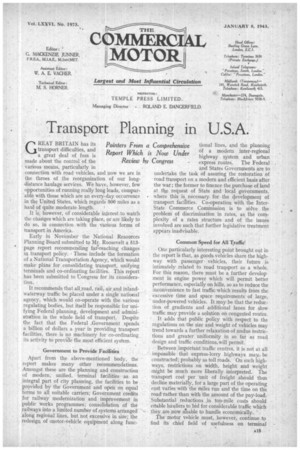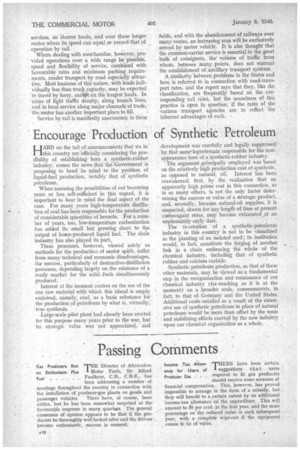Transport Planning in U.S.A.
Page 17

Page 18

If you've noticed an error in this article please click here to report it so we can fix it.
GREAT BRITAIN has its transport difficulties, and . a great deal of fuss is 'made about the control of the various means, particularly in connection with road vehicles, and now we are in the throes of the reorganization of our longdistance haulage services. We have, however, few opportunities of running really long leads, comparable with those which are an every-day occurrence in the United States, which regards500 miles as a haul of quite moderate length.
It is, however, of considerable interest to watch the changes which are taking place, or are likely to do so, in connection with the various forms of transport in America.
Early in November the National Resources Planning Board submitted to M. Roosevelt a 513page report recommending far-reaching changes in transport policy. • These include the formation of a National Transportation Agency, which would makeplans for consolidating transport, unifying terminals and co-ordinating facilities. This report has been submitted to tongress for its consideration.
It recommends that all road, rail, air and inlandwaterway traffic be placed under a single national agency, which would co-operate with the various regulating bodies, but itself be responsible for unifying Federal planning, development and administration in the whole field of transport. Despite the fact that the Federal .Government spends a billion of dollars a year in providing transport facilities, there is no machinery for co-ordinating its activity to provide the most efficient system.
Government to Provide Facilities Apart from the above-mentioned body, the report makes many other recommendations. Amongst these are the planning and construction of modern, unified, terminal facilities as an integral part of city planning, the facilities to be provided by the Government and open on equal terms to all suitable carriers; Government credits for railway modernization and improvement in public works programmes; consolidation of the railways into a limited number of systems arranged along regional lines, but not excessive in size; the redesign of motor-vehicle equipment along func tional lines, and the planning of a modern inter-regional highway system and urban express routes. The Federal and States Governments are to undertake the task of assuring the restoration of • road transport on a modern and efficient basis after the war; the former to finance the purchase of land at th,e request of State and local governments, where this is necessary. for the development of transport facilities. Co-operation with the InterState Commerce Commission is to solve the problem of discrimination in rates, as the complexity of a rates structure and of the issues involved are such that further legislative treatment appears inadvisable.
Common Speed for All Traffic' One particularly interesting point brought out in the report is that, as goods vehicles share the highway with passenger • vehicles, their future is intimately related to road traRsport as a whole. For this reason, there must be a further development in engine power which will permit better performance, especialfy on hills, so as to reduce the inconvenience to fast traffic which results from the excessive time and space requirements of large, under-powered vehicles. It may be that the reduction of gradients and additional lanes for slow traffic may provide a solution on congested routes.
It adds that public policy with respect to the regulations on the size and weight of vehicles may trend towards a further relaxation of undue restrictions and greater uniformity in so far as road design and traffic conditions,will permit.
Between important traffic centres, it is not at all impossible that express-lorry highways may.. be constructed; probably as toll roads. On such highways, restrictions on width, height and weight might be much more liberally interpreted. The transport cost per "unit of freight should thus decline materially, for a large part of the operating cost varies with the miles run and the time on the road rather than with the amount of the pay-load. Substantial reductions in ton-mile costs should enable hauliers to.bid for considerable traffic which they are now unable to handle economically.
The motor vehicle must, however, continue to find its chief field of usefulness on terminal services, on 'shorter hauls, and over those longer routes where its speed can equal or exceed that of operation by rail.
Where dealing with merchandise, 'however, proVided operations over a wide range be possible, speed and flexibility of service, combined with favourable rates and minimum packing requirements, render transport by road especially attractive. Mo'st business of this-nature, with loads individually less than truck capacity, may be expected *to travel by lorry, except on the longest hauls. In areas of light traffic density, along branch lines, and in local service along major channels of trade, the motor has another important place to fill. • Service by rail is manifestly uneconomic in these fields, and with the abandonment of railways over many routes, an increasing area will be exclusively served by motor vehicle. It is also thought that the common-carrier service is essential to the great bulk of consignors, the' volume of traffic from whom, between many points, does not warrant the establishment of ancillary transport systems.
A similarity'between problems in the States and here is referred to in connection with road-transport rates, and the report says that they, like the classification, are frequently based on the corresponding rail rates, but the soundness of this practice is open to question, if the rates of the various transport agencies are to reflect the inherent advantages of each.




















































